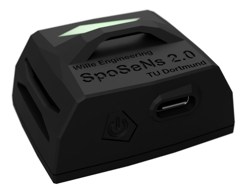Back to articles
Wireless solutions take sports tracking to new level
![]()
The ability to integrate location and movement sensors with wireless technology in sports equipment is revolutionizing the way athletic performance can be monitored, analyzed and improved.
Smart sports equipment
Small-sized wireless sports tracking solutions with long battery life now enable previously impossible integration. Balls, bats, pucks, boots, helmets, and other gear play host to compact wireless tech without affecting the characteristics or performance of the equipment. In a world where “marginal gains” make the difference between winning and losing, wireless sports tracking is now mandatory. That goes some way to explaining why the industry is proving so lucrative; industry analyst Grand View Research expects the sector to register a CAGR of 20.3 percent from 2018 (when it was valued at $9.8 billion) up to 2025.
Today’s built-in sensors or technology track the precise location and movement of the sports equipment in action, analyze the data and then forward it via a short-range wireless link to an accompanying app on the user’s smartphone or a web-based dashboard on their laptop.
One example is pitchLogic, a baseball with a ‘brain’ that tracks its position and movement to provide critical data about each pitch. Developed by sports technology start-up, F5 Sports, the Bluetooth LE-enabled smart ball uses built-in sensors and complex proprietary algorithms to analyze the pitch in mid-air, taking approximately 75,000 measurements as the ball travels. Clay Holmes, a pitcher for Major League Baseball (MLB) team the Pittsburgh Pirates, has credited the unique data and insights provided by the pitchLogic system with helping him to discover the optimal body and arm slot positions for successful pitches, particularly in relation to his renowned ‘sinker’, a type of fastball characterized by significant downward and horizontal movement.
Advanced sports training wearable
Wireless tech isn’t only helping improve ball game skills. German researchers at the TU Dortmund’s Institute for Sport and Sport Science (including Dr. Marcus Schmidt, Researcher Institute for Sport and Sport Science, and Prof. Dr. Thomas Jaitner, TU Dortmund), in conjunction with Kaiserslautern-based tech developer Wille Engineering, for example, have launched the SpoSeNs 2.0 Professional Wearable, a lightweight, ankle-worn device for reliable and accurate analysis of an athlete’s movement and biomechanical parameters.
 In comparison to a regular fitness wearable, SpoSeNs 2.0 is designed to provide greater precision and more comprehensive data to enhance sports training and competitive performance. The solution can be used to collect and analyze detailed sprint, jump and hurdle metrics/insights which previously required complex and often expensive system installations—including light barriers, force plates, or video cameras—as well as frequent recalibration. For example, the platform’s proprietary step-detection algorithm determines the athlete’s ground contact time or step frequency in real-time.
In comparison to a regular fitness wearable, SpoSeNs 2.0 is designed to provide greater precision and more comprehensive data to enhance sports training and competitive performance. The solution can be used to collect and analyze detailed sprint, jump and hurdle metrics/insights which previously required complex and often expensive system installations—including light barriers, force plates, or video cameras—as well as frequent recalibration. For example, the platform’s proprietary step-detection algorithm determines the athlete’s ground contact time or step frequency in real-time.
“In professional training and competition, every millisecond counts,” says Sebastian Wille, Founder of Wille Engineering. “In sprint and hurdle disciplines, for example, the athlete needs to know the point in a race when they start to fatigue, and real-time feedback is crucial to ensure suitable adaptions can be made during conditioning training.
“SpoSeNs 2.0 is a universal solution for various sports applications; new use cases could be found in different sports including volleyball, beach volleyball, badminton, boxing, and horse riding,” Wille says.
Nordic power
The SpoSeNs 2.0 Professional Wearable is built round Nordic Semiconductor’s nRF52840 advanced multiprotocol SoC. In addition to the SoC, the product comprises a sensor node, a nine-axis IMU, and a separate three-axis, high-G accelerometer. Supported by the SoC’s powerful microprocessor and large memory, SpoSeNs 2.0 records the wearer’s movement data then processes the raw data in ‘real-time’. Using the SoC-enabled low latency Bluetooth LE connectivity, the data is then sent to a paired smartphone or tablet. The trainer can access live performance information and graphic-based analytics directly through an associated Android app.
The future of sports tracking
“Technologies like SpoSeNs 2.0 can take sports training and therefore performance for professional athletes to a new level,” Wille says. “At the same time, it’s also entirely possible for such a system to be used by all classes of athletes.”
He’s right. ‘Smart’ sports equipment and wearables have the potential to hugely impact the future of sports tracking and performance analytics for all. And OEMs in this space will be able to boost their bottom lines just as competitors raise their aspirations.
When just about every performance metric imaginable can be accurately tracked using a commercially viable, cost-effective, and readily available wireless tech solution, skills, techniques, and ultimately the performance levels of millions of athletes around the world will improve. Thanks to wireless tech, perfect practice could soon be standard practice.


